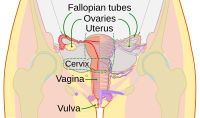
Photo from wikipedia
Vaginal and cervical canal bacteria are associated with women’s health and pregnancy outcomes. Here, we compared their composition and characteristics in 37 reproductive-aged Chinese women including 24 pregnant women with… Click to show full abstract
Vaginal and cervical canal bacteria are associated with women’s health and pregnancy outcomes. Here, we compared their composition and characteristics in 37 reproductive-aged Chinese women including 24 pregnant women with cervical incompetence (vaginal and cervical canal bacteria formed Groups A and B, respectively) and 13 healthy pregnant women (vaginal and cervical canal bacteria formed Groups C and D, respectively) using high-throughput sequencing of the V4 region of 16S rRNA gene. The results of alpha and beta diversity analysis, respectively, indicated no statistical differences between Groups A and B (p = 0.32, 0.06), nor Groups B and D (p = 0.69, 0.74); however, differences were found between Groups C and D (p = 0.02, 0.01) and between Groups A and C (p = 0.04, 0.02). PLS-DA analysis showed that the individuals from each group were irregularly distributed according to their clade. Lactobacillus, Bifidobacterium and Ureaplasma were the dominant genera in all groups. Phylogenetic Investigation of Communities by Reconstruction of Unobserved States (PICRUSts) analysis identified 31 Kyoto Encyclopedia of Genes and Genomes (KEGG) orthologs associated with the bacterial communities from the four groups, including membrane transport, folding, sorting and degradation, xenobiotics biodegradation and metabolism, and nucleotide metabolism. We further determined relationships between pregnancy outcomes (Apgar scores) and certain bacterial species. A significant positive correlation was found between Apgar scores and Actinomyces neuii and Anoxybacillus flavithermus in the vagina and cervical canal of pregnant women with cervical incompetence while Bacteroides plebeius, Bifidobacterium pseudopodium and Staphylococcus petrasii in the cervical canal displayed negative correlations with Apgar scores. Moreover, Clostridium fimetarium, Methanobacterium congolense, Pseudomonas chlororaphis, and Psychrobacter nivimaris in the vagina were negatively correlated with Apgar scores. These bacteria may serve as potential biomarkers, however, additional research is warranted to verify their role in clinical outcomes.
Journal Title: Frontiers in Microbiology
Year Published: 2022
Link to full text (if available)
Share on Social Media: Sign Up to like & get
recommendations!